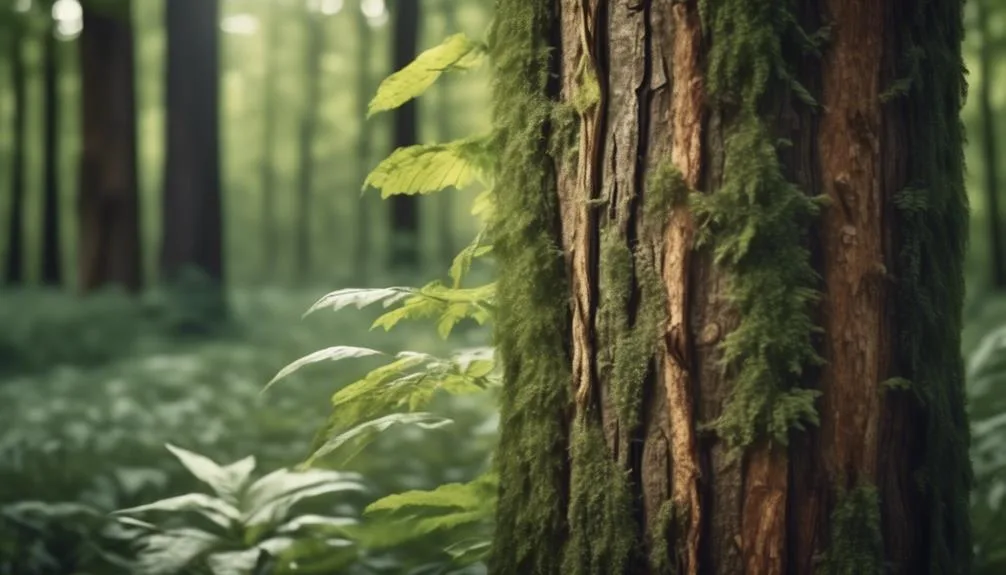Hickory trees are more than just part of the scenery. They play a vital role in their ecosystems, benefiting biodiversity in various ways.
From their relationships with wildlife to their support for native species, hickory trees are essential for the balance of nature.
Whether you're a nature lover or simply interested in the web of life, understanding the importance of hickory trees in biodiversity is worth exploring.
Hickory Trees and Biodiversity
Hickory trees play a crucial role in supporting biodiversity by providing food and habitat for a wide range of species in their ecosystem. The deep roots of hickory trees help improve soil health by preventing erosion and promoting nutrient cycling.
Their large tree canopy provides shade and shelter for smaller plants and animals, creating a diverse microhabitat. This diverse microhabitat supports a variety of wildlife, from insects to birds and mammals. The fallen leaves and nuts from hickory trees also contribute to the richness of the forest floor, providing sustenance for many organisms.
In this way, hickory trees act as a cornerstone species, influencing the overall health and diversity of the ecosystem. Their presence not only benefits the wildlife directly associated with them but also contributes to the overall richness and balance of the entire ecosystem.
Role of Hickory Trees in Ecosystem
Improving soil health and providing essential food and habitat for a wide range of species, hickory trees play a crucial role in supporting biodiversity within their ecosystem. Here's how they contribute:
- Hickory tree diversity: Hickory trees are known for their diverse species, each with its unique characteristics and interactions within the ecosystem. This diversity contributes to the overall resilience of the ecosystem, as different species of hickory trees support a variety of wildlife and plant species.
- Ecosystem resilience: Hickory trees play a vital role in maintaining the resilience of the ecosystem. Their deep roots help prevent soil erosion, while their leaf litter enriches the soil, supporting the growth of other plants and microorganisms. This, in turn, creates a more robust and resilient ecosystem, better equipped to withstand environmental changes.
- Supporting wildlife: Hickory trees provide food and shelter for a wide variety of wildlife, including birds, squirrels, and insects. This creates a thriving ecosystem where different species depend on hickory trees for survival, ultimately enhancing biodiversity.
Biodiversity Impact of Hickory Trees
Supporting a diverse array of wildlife and fostering ecosystem resilience, hickory trees have a profound impact on biodiversity within their habitat.
The presence of hickory trees promotes biodiversity by providing food and shelter for various species. Their nuts are a crucial food source for animals like squirrels, deer, and birds, contributing to the overall richness of the ecosystem. Additionally, hickory trees support a wide range of insects, which in turn attract insectivorous birds and other wildlife, further enhancing biodiversity.
The ecological significance of hickory trees extends beyond their immediate surroundings, as they play a vital role in maintaining the balance of the forest ecosystem. By influencing the composition of plant and animal communities, hickory trees contribute to the overall health and resilience of the environment, making them a key player in biodiversity promotion.
Importance of Hickory Trees for Wildlife
By providing essential food and shelter, hickory trees play a crucial role in supporting a diverse array of wildlife, contributing significantly to the overall richness of the ecosystem. Hickory tree habitats are essential for many wildlife species due to the following reasons:
- Food Source: Hickory nuts are a vital food source for numerous wildlife species, including squirrels, deer, wild turkey, and various bird species. The nuts provide essential fats and nutrients, especially during the winter months when food sources may be scarce.
- Shelter and Nesting Sites: The dense foliage and sturdy branches of hickory trees offer ideal shelter and nesting sites for a wide range of wildlife, including birds, squirrels, and small mammals. This contributes to the overall biodiversity of the area.
- Ecosystem Balance: The presence of hickory trees supports wildlife conservation efforts by maintaining a balanced and healthy ecosystem, promoting species diversity, and providing a sustainable environment for various organisms.
Conservation Value of Hickory Trees
With its unique ecological significance, hickory trees are vital for the conservation of diverse wildlife and the overall health of ecosystems. These trees provide significant conservation benefits by serving as crucial habitats for various animal species.
The nuts produced by hickory trees are a vital food source for many creatures, including birds, squirrels, and other small mammals, contributing to the overall biodiversity of forest ecosystems. Additionally, hickory trees play a key role in soil conservation, as their deep roots help prevent erosion and stabilize the surrounding soil.
Their presence also supports a rich understory of plants, further enhancing the ecological significance of hickory-dominated habitats. By preserving hickory trees, we contribute to the conservation of not only these majestic trees themselves but also the diverse array of life that depends on them.
Conclusion
In appreciating the significance of hickory trees, we also safeguard the rich tapestry of wildlife and the health of our ecosystems.
Let's continue to protect and celebrate these vital contributors to biodiversity for the well-being of future generations.
Mark Hoffman is a dedicated arborist and tree care specialist with over a decade of experience. His love for trees began when he visited Yosemite National Park as a teenager and was awestruck by the giant sequoias. Mark pursued his passion by studying forestry at Michigan Technological University, where he earned a Bachelor of Science degree.
Since then, he has worked tirelessly in the field of arboriculture, helping to preserve and protect trees in his community. His expertise and dedication have made him a respected leader in the industry and a valuable resource for anyone seeking advice on tree care.
